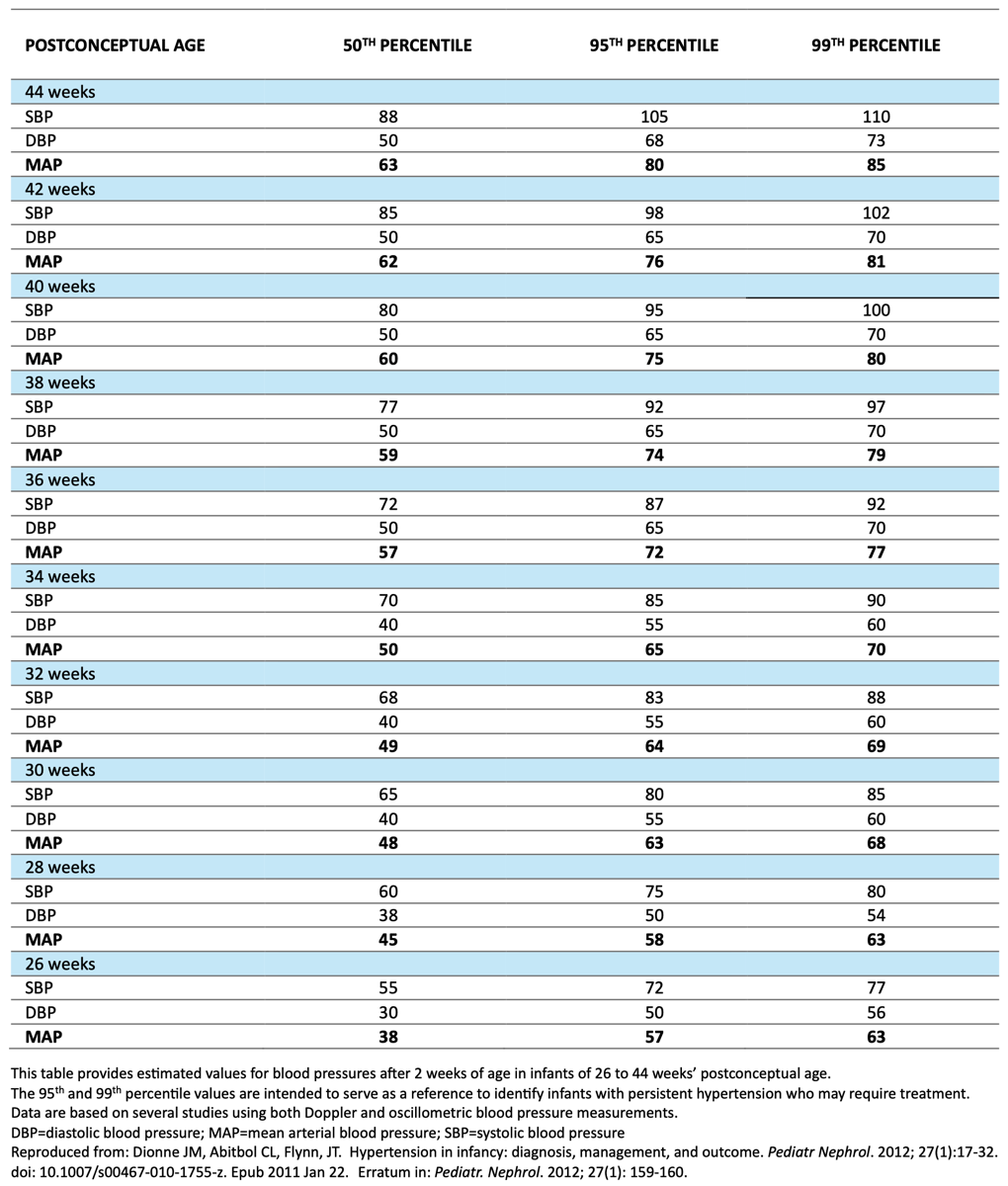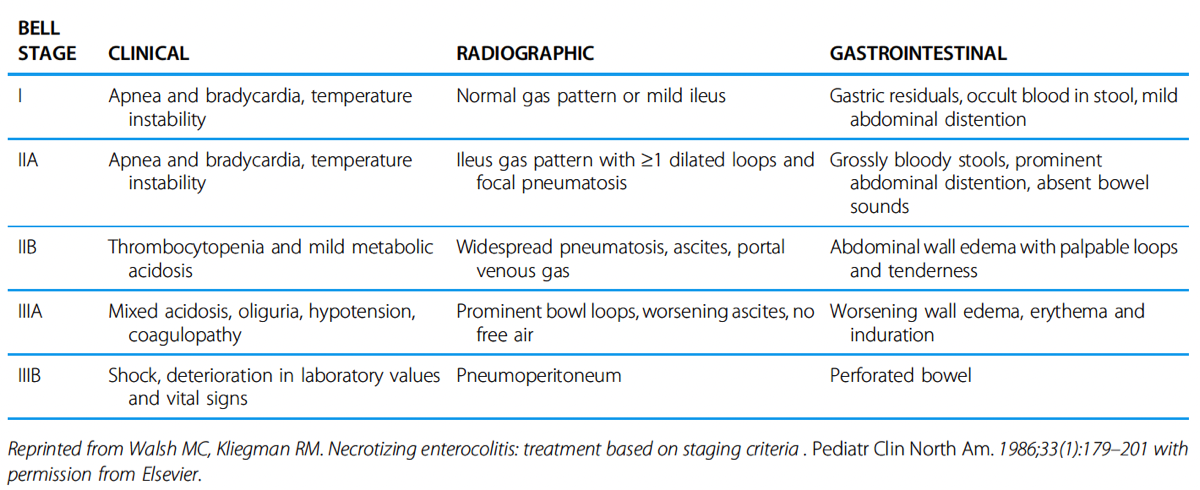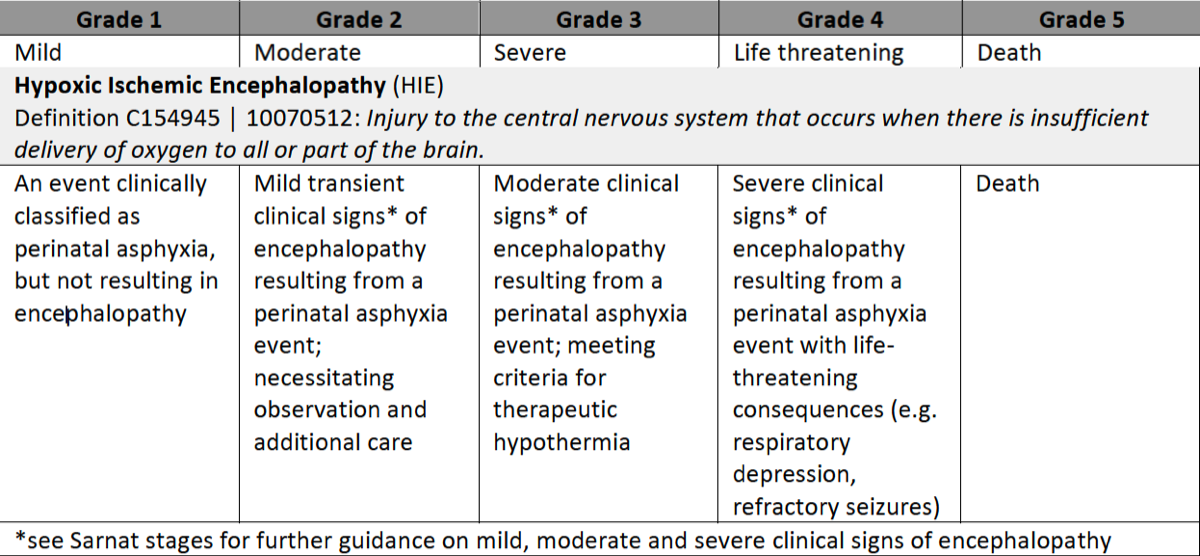


This list of Adverse Event (AE) terms is NOT exhaustive.
Please document all AEs as required by the protocol.
This tool lists the 35 Neonatal Adverse Event Severity Scale (NAESS) AE terms and the selection of the most common neonatal AE terms. This tool is intended to assist users with reporting AEs. NAESS terms with their AE-specific severity criteria should be selected whenever applicable. For all other AEs, the AE grade should be reported using the NAESS generic severity criteria.

- If different factors result in conflicting severity grades, the highest grade should be reported.
- If the AE is part of a larger diagnosis, please merge the term into a narrative of overarching/unifying AE.
- If the AE is a laboratory abnormality, sign, or symptom, please update AE to the final diagnosis.

If the AE is not on the list, please report the AE and grade the AE severity using the NAESS generic severity criteria HERE.
0
filter_list
-
Neonatal Bradyarrhythmiaexpand_less

Additional Information and Considerations for the SAE Narrative:- Heart rate (threshold and range) at baseline prior to event, event onset, nadir, and resolution
- EKG and ECHO findings
- Clinical manifestations (including duration and temporal pattern) and course
- Possible causes or contributing factors
- Treatment, interventions, and response
-
Neonatal Coagulation Disorderexpand_less
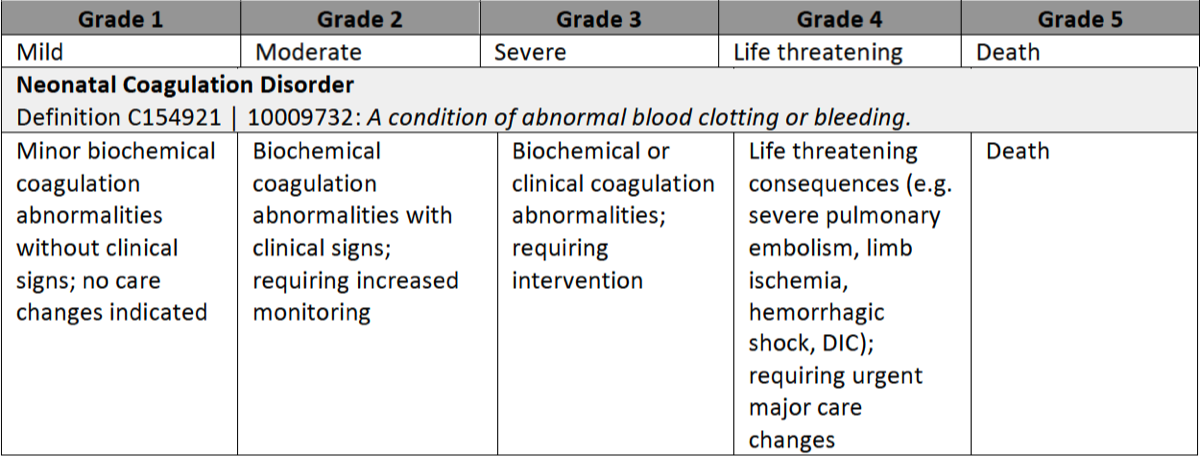
Additional Information and Considerations for the SAE Narrative:- Coagulation values (event onset, peak, and resolution) with units and reference range
- Relevant other laboratory tests with units and reference ranges: hematocrit, platelets, hepatic function panel
- Duration and temporal pattern
- Possible causes or contributing factors
- Treatment (e.g., transfusions of blood products, vitamin K, IVIG), interventions, and response
-
Neonatal Edemaexpand_less

Additional Information and Considerations Required for the SAE Narrative:Peripheral Edema (includes anasarca)- Laboratory abnormalities with units and reference range: electrolytes, blood urea nitrogen, creatinine, albumin
- Duration and temporal pattern
- Possible causes or contributing factors
- Treatment, interventions, and response
Pulmonary Edema- Laboratory tests with units and reference range: electrolytes, blood urea nitrogen, creatinine, albumin, hematocrit, B-type natriuretic peptide (BNP)
- Duration and temporal pattern
- Possible causes or contributing factors
- Treatment (e.g., diuretic), interventions (e.g., supplemental O2, respiratory support), and response
-
Neonatal Hypertensionexpand_less
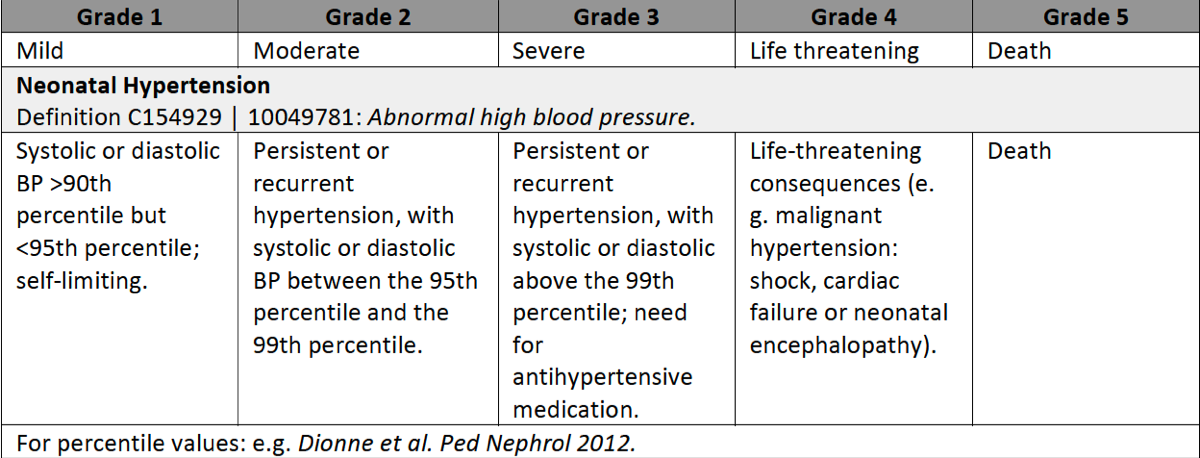
Additional Information and Considerations for the SAE Narrative:- Blood pressure (threshold and range) at baseline before event, event onset, peak, and resolution
- Clinical manifestations (including duration and temporal pattern) and course
- Findings on EKG, ECHO, and abdominal ultrasound with Dopplers
- Possible causes or contributing factors
- Treatment, interventions, and response
-
Neonatal Hypotensionexpand_less
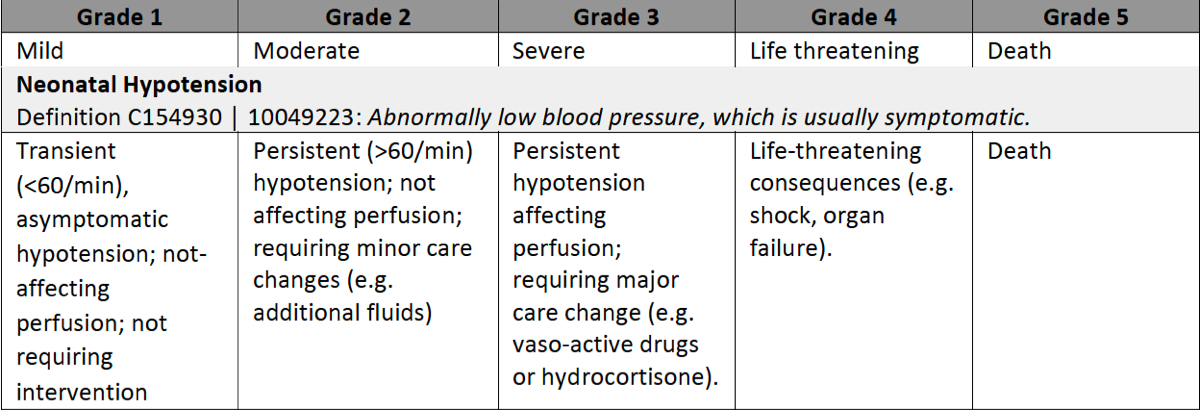
Additional Information and Considerations for the SAE Narrative:- Blood pressure (threshold and range) at baseline prior to event, event onset, nadir, and resolution
- Clinical manifestations (including duration, perfusion, and organ involvement) and course
- EKG, ECHO, and head ultrasound findings
- Possible causes or contributing factors
- Treatment, interventions, and response
-
Neonatal Sinus Bradycardiaexpand_less
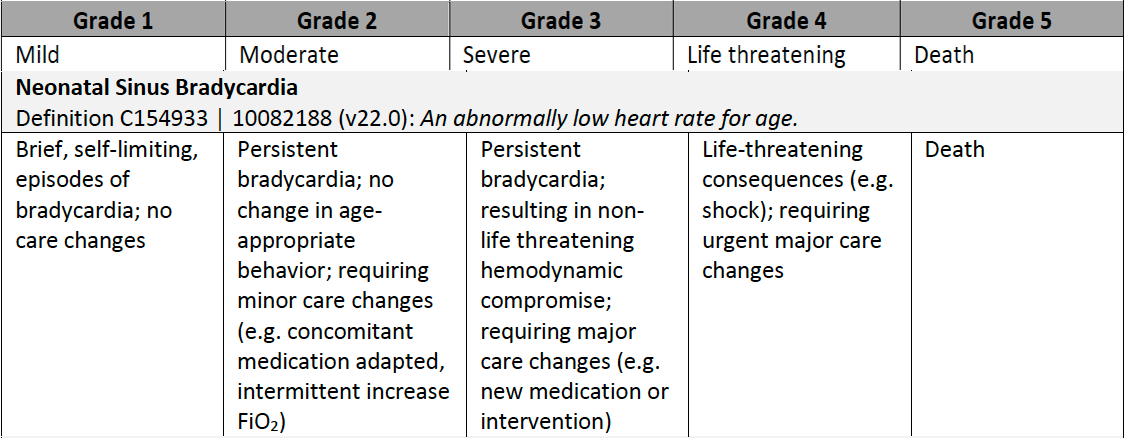
Additional Information and Considerations for the SAE Narrative:- Heart rate (threshold and range) at baseline prior to event, event onset, nadir, and resolution
- Clinical manifestations (including duration and temporal pattern) and course
- EKG and ECHO findings
- Possible causes or contributing factors
- Treatment, interventions, and response
-
Neonatal Sinus Tachycardiaexpand_less
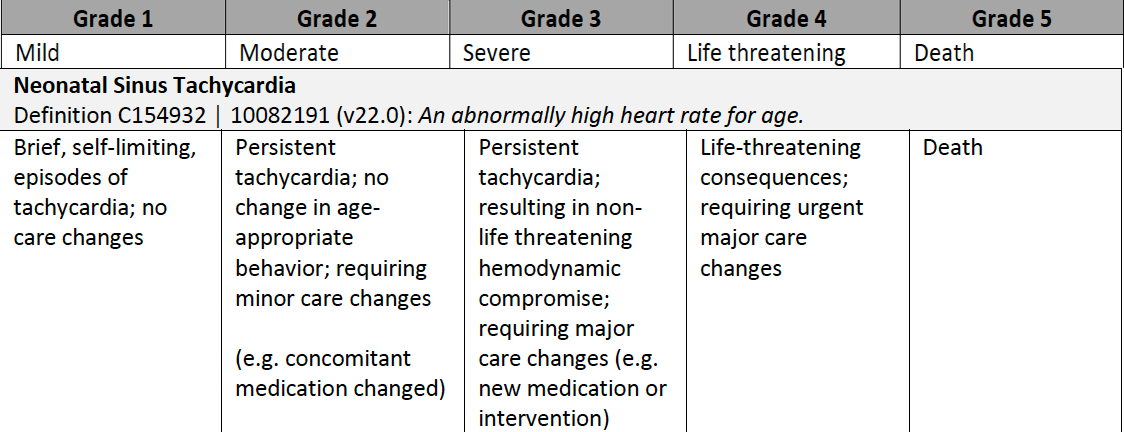
Additional Information and Considerations for the SAE Narrative:- Heart rate (threshold and range) at baseline prior to event, event onset, peak, and resolution
- Clinical manifestations (including duration and temporal pattern) and course
- EKG and ECHO findings
- Possible causes or contributing factors
- Treatment, interventions, and response
-
Neonatal Tachyarrhythmiaexpand_less
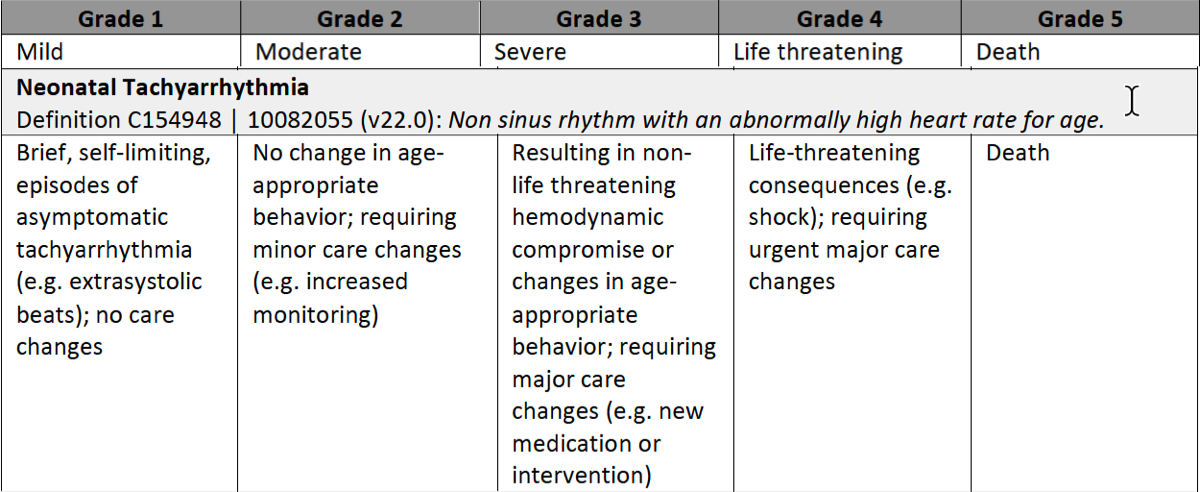
Additional Information and Considerations for the SAE Narrative:- Heart rate (threshold and range) at baseline prior to event, event onset, peak, and resolution
- Clinical manifestations (including duration and temporal pattern) and course
- EKG and ECHO findings
- Possible causes or contributing factors
- Treatment, interventions, and response
-
Feeding Intoleranceexpand_less
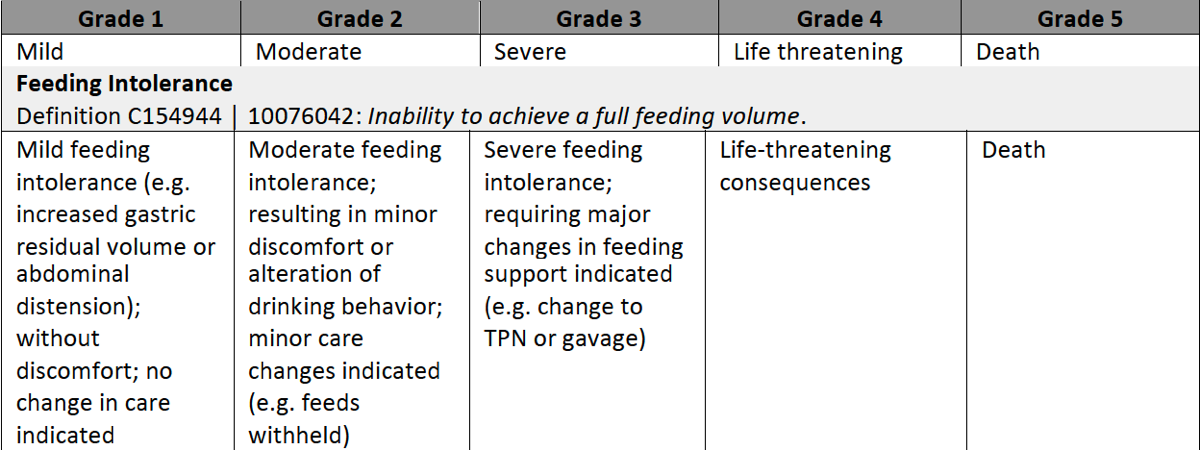
Additional Information and Considerations for the SAE Narrative:- Clinical manifestations and course
- Provide details on feeding regimen (type, volume, frequency, route, start/stop dates)
- Concurrent medications (e.g., caffeine, anti-reflux, probiotic)
- Relevant associated laboratory tests (e.g., Blood gas, CBC, coagulation profile, CRP, cultures)
- Possible causes or contributing factors
- Treatment, interventions, and response
-
Infantile Vomitingexpand_less
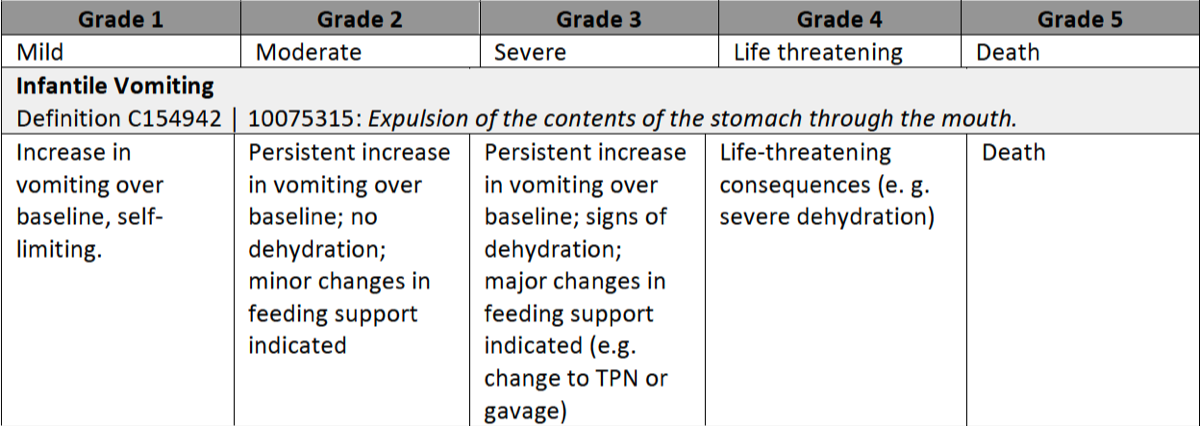
Additional Information and Considerations for the SAE Narrative:- Clinical manifestations and course
- Provide details on feeding regimen (type, volume, frequency, route, start/stop dates)
- Possible causes or contributing factors
- Treatment, interventions, and response
-
Necrotizing Enterocolitis (NEC)expand_less
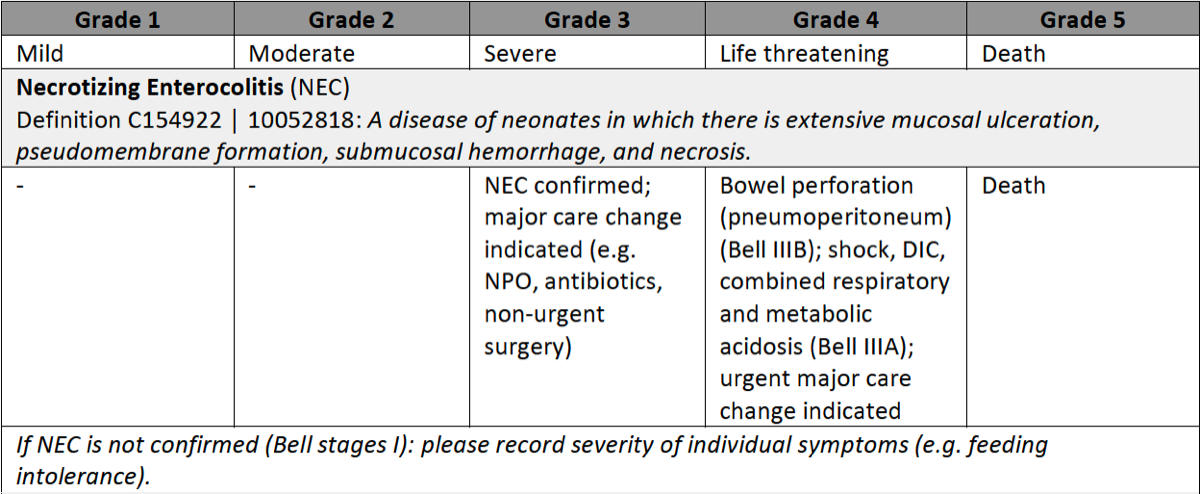
Additional Information and Considerations for the SAE Narrative:- Clinical manifestations and course
- Feeding regimen details (date of first feed, type, volume, frequency, route, start/stop dates)
- Relevant associated laboratory tests (e.g., Blood gas, CBC, coagulation studies, CRP, cultures)
- CRP, cultures)
- Possible causes or contributing factors
- Treatment, interventions, and response
-
Neonatal Constipationexpand_less
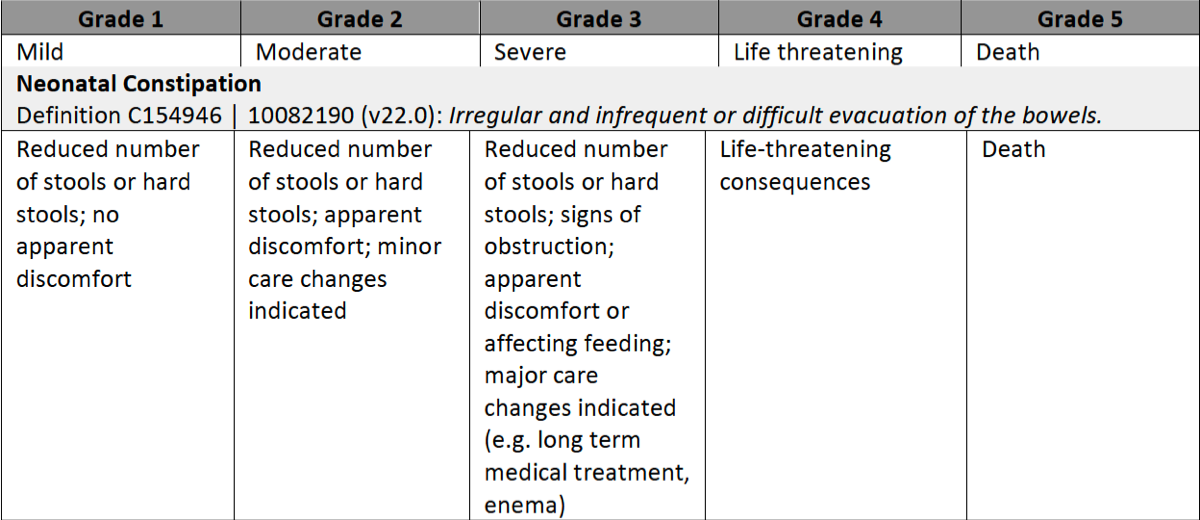
Additional Information and Considerations for the SAE Narrative:- Clinical manifestations (include frequency and quality of stools at baseline prior to event and event onset) and course
- Feeding regimen details (type, volume, frequency, route, start/stop dates) and any associated signs of obstruction
- Relevant associated laboratory tests and radiographic findings
- Possible causes or contributing factors
- Treatment, interventions, and response
-
Neonatal Diarrheaexpand_less

Additional Information and Considerations for the SAE Narrative:- Clinical manifestations (include frequency and quality of stools at baseline prior to event and event onset) and course
- Feeding regimen details (type, volume, frequency, route, start/stop dates) and any associated signs of dehydration
- Relevant associated laboratory tests and radiographic findings
- Possible causes or contributing factors
- Treatment, interventions, and response
-
Neonatal Gastrointestinal (GI) Bleedingexpand_less
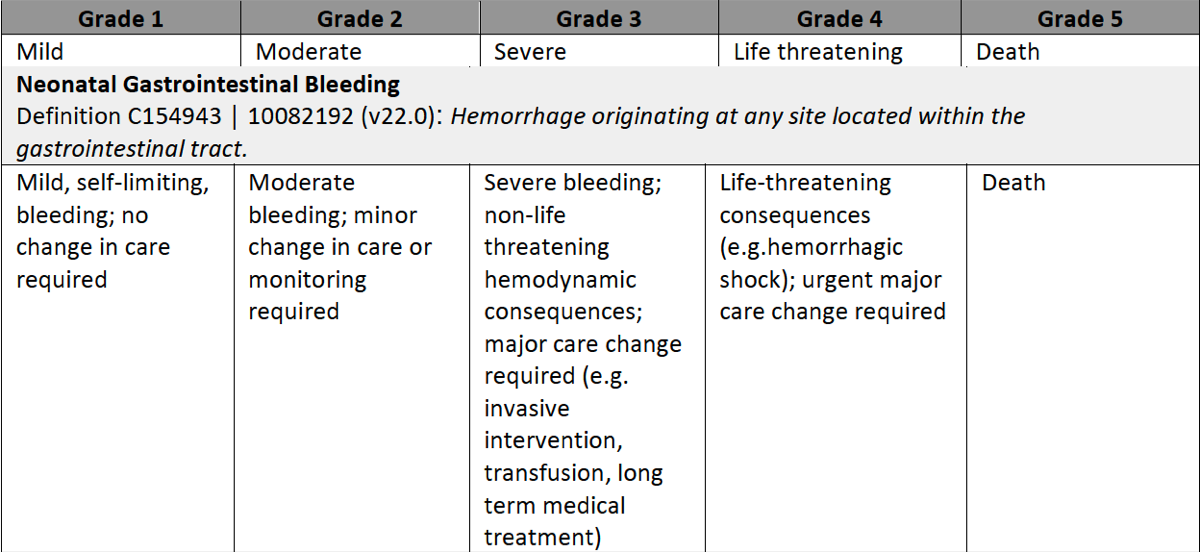 The GI tract refers to only the stomach, small intestine, and large intestine.
The GI tract refers to only the stomach, small intestine, and large intestine.
Additional Information and Considerations for the SAE Narrative:- Clinical manifestations and course
- Relevant associated laboratory tests (e.g., CBC, coagulation studies, fibrin degradation product (FDP), hepatic function panel) with test units and reference ranges
- Radiographic findings
- Possible causes or contributing factors
- Treatment, interventions (e.g., endoscopy), and response
-
Neonatal Spontaneous Intestinal Perforation (SIP)expand_less

Additional Information and Considerations for the SAE Narrative:- Clinical manifestations and course
- Feeding regimen details (date of first feed, type, volume, frequency, route, start/stop dates)
- Concurrent medications (e.g., caffeine, anti-reflux, probiotic)
- Relevant associated laboratory tests (e.g., Blood gas, CBC, coagulation studies, CRP, cultures)
- Possible causes or contributing factors
- Treatment, interventions, and response
-
Neonatal Administration Site Reaction (Complication)expand_less

Additional Information and Considerations for the SAE Narrative:- Vascular access details: location, type (peripheral IV, PICC, UVC, UAC, PAL), date of placement +/- date of removal
- Reaction/complication details: erythema, edema, pain, induration, phlebitis, ulceration/necrosis, pulses proximal to the affected area
- phlebitis, ulceration/necrosis, and pulses proximal to the affected area).
- Radiographic (x-ray, ultrasound with Doppler) findings
- Treatment, interventions, and response
-
Neonatal Feverexpand_less
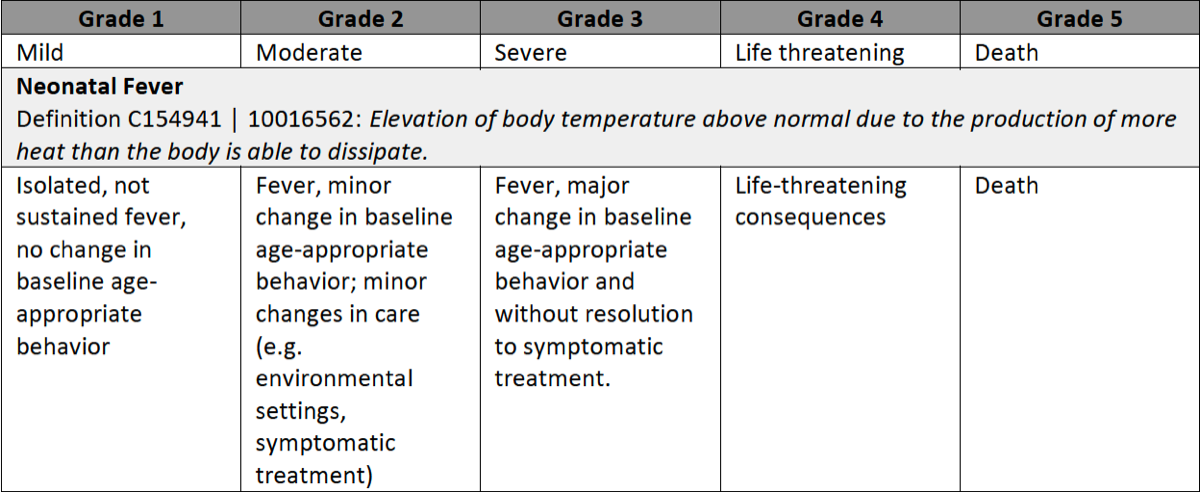
Additional Information and Considerations for the SAE Narrative:- Specify elevated body temperature (threshold or range)
- Evaluation: environmental settings at time of fever, infection work-up, etc.
- Duration and temporal pattern
- Possible causes or contributing factors
- Treatment, interventions, and response
-
Neonatal Rashexpand_less
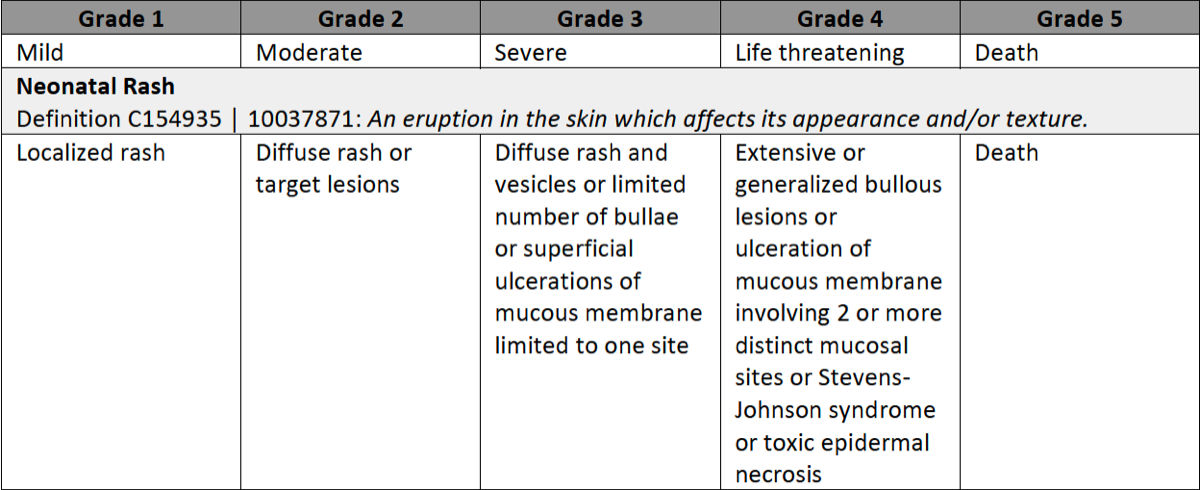
Additional Information and Considerations for the SAE Narrative:- Clinical manifestations and course
- Rash details at each site: location, focal versus generalized, morphology (target, vesicles, bullae), mucous membrane involvement
- Relevant associated laboratory tests
- Possible causes or contributing factors
- Treatment, interventions, and response
-
Neonatal Culture Negative Sepsisexpand_less

Additional Information and Considerations for the SAE Narrative:- Clinical manifestations (include abnormalities in vital signs and physical exam) and course
- Vascular access details: location, type (peripheral IV, PICC, UVC, UAC, PAL), date of placement +/- date of removal
- Relevant laboratory tests (e.g., Blood gas, CBC, coagulation studies, CRP, and blood culture), including test date, site of blood culture collection, test result with units, and reference range
- Possible causes or contributing factors
- Treatment, interventions, and response
-
Neonatal Culture Positive SepsisAESIexpand_less

Additional Information and Considerations for the SAE Narrative:- Clinical manifestations (include abnormalities in vital signs and physical exam) and course
- Vascular access details: location, type (peripheral IV, PICC, UVC, UAC, PAL), date of placement +/- date of removal
- Relevant laboratory tests (e.g., Blood gas, CBC, coagulation studies, CRP, blood culture with organism identification and antibiotic sensitivities), including test date, site of blood culture collection, and test result with units and reference range
- Possible causes or contributing factors include central-line associated bloodstream infection (CLABSI)
- Treatment, interventions, and response
-
Hypoxic Ischemic Encephalopathy (HIE)expand_less
-
Infant Irritabilityexpand_less
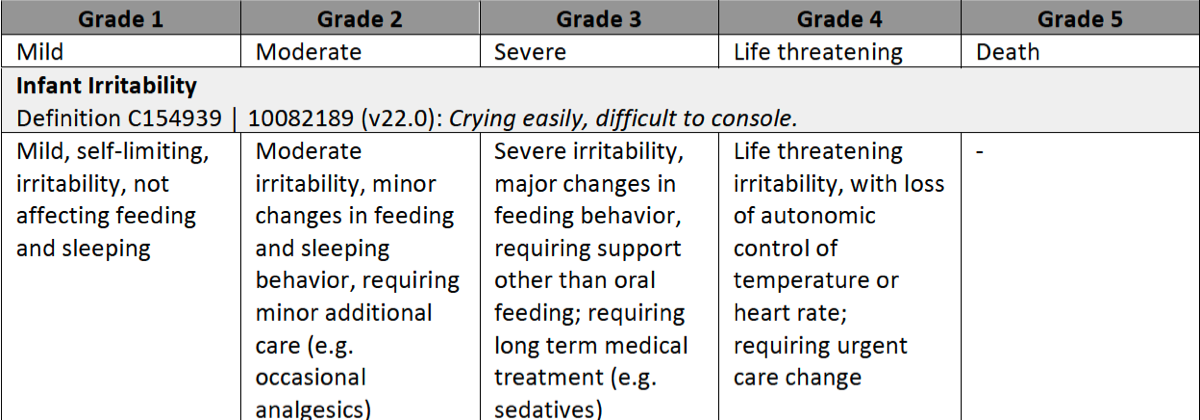
Additional Information and Considerations for the SAE Narrative:- Clinical manifestations (include abnormalities in vital signs and neurologic exam, feeding difficulties or intolerance) and course • Possible causes or contributing factors
- Treatment (e.g., analgesics, sedatives), non-pharmacologic interventions, and response
-
Infant Sedationexpand_less

Additional Information and Considerations for the SAE Narrative:- Clinical manifestations (include abnormalities in vital signs and neurologic exam, respiratory support, feeding difficulties) and course
- Possible causes or contributing factors
- Treatment, interventions, and response
-
Neonatal Convulsionexpand_less
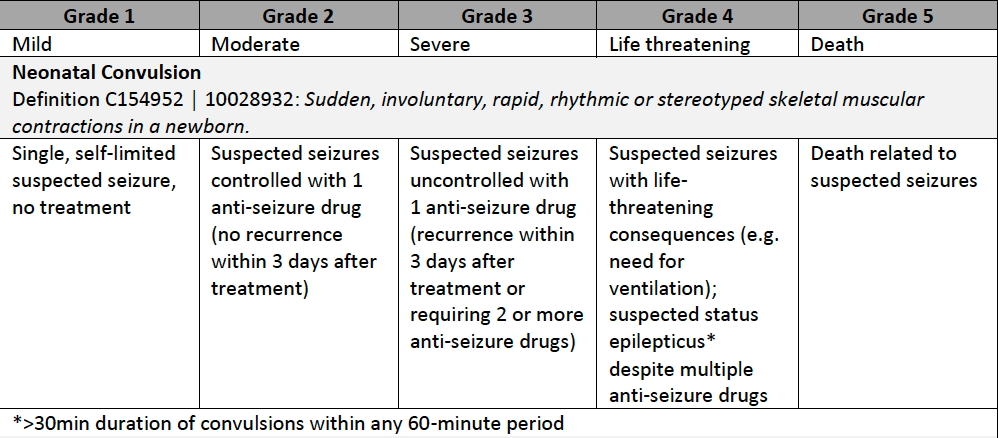
Additional Information and Considerations for the SAE Narrative:- Clinical manifestations (include abnormalities in vital signs and neurologic exam, seizures, feeding difficulty, escalation in respiratory support) and course
- Neuroimaging and EEG findings
- Possible causes or contributing factors
- Treatment, interventions, and response
-
Neonatal Epileptic Seizureexpand_less
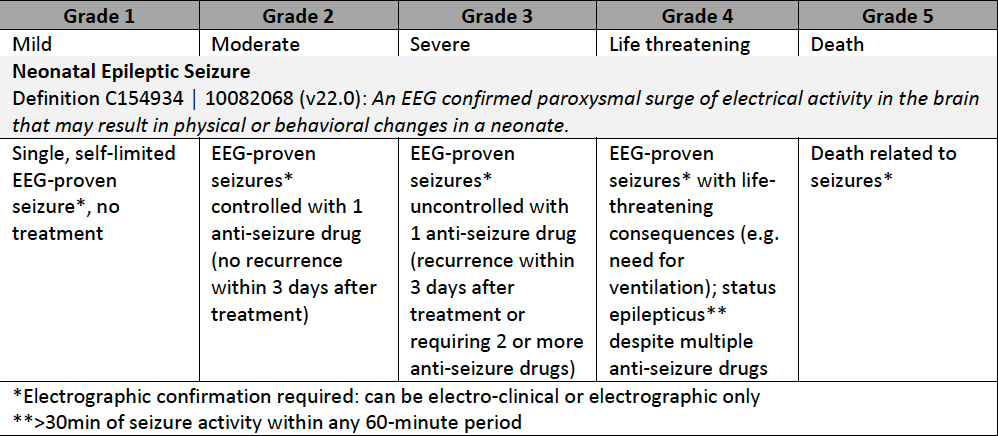
Additional Information and Considerations for the SAE Narrative:- Clinical manifestations (include abnormalities in vital signs and neurologic exam, seizures, feeding difficulty, escalation in respiratory support) and course
- Neuroimaging and EEG findings
- Possible causes or contributing factors
- Treatment, interventions, and response
-
Neonatal Intraventricular Hemorrhage (IVH)expand_less
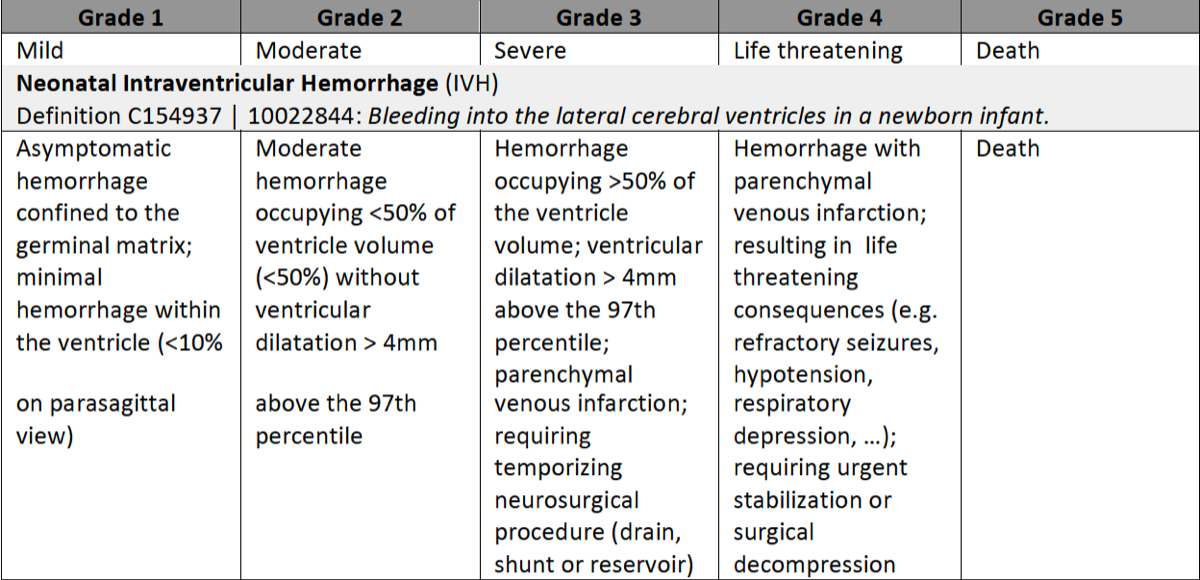
Additional Information and Considerations for the SAE Narrative:- Clinical manifestations (include abnormalities in vital signs and neurologic exam, seizures, apnea, feeding difficulty) and course
- Neuroimaging findings
- Possible causes or contributing factors
- Treatment, interventions, and response
-
Periventricular Leukomalacia (PVL)expand_less
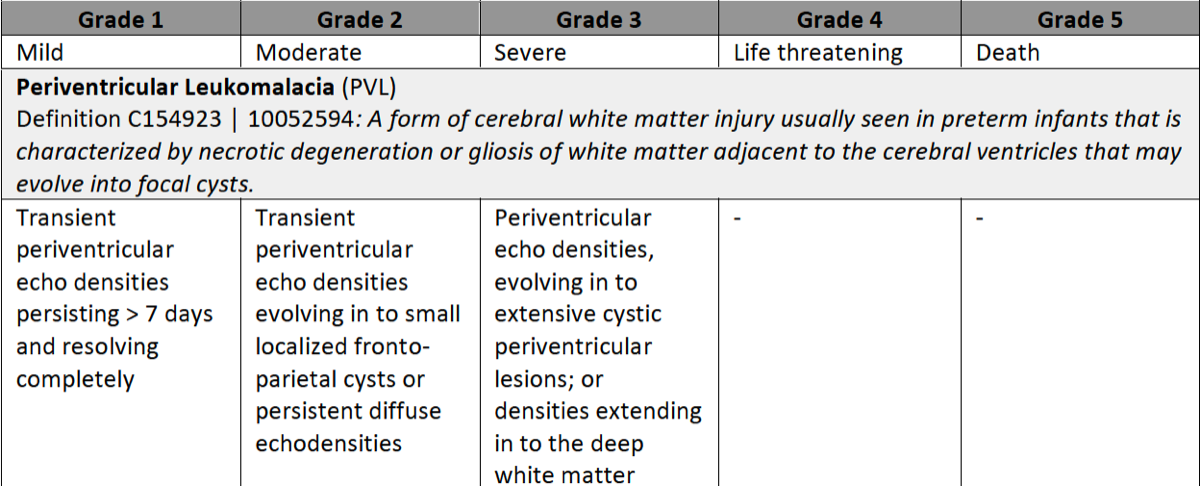
Additional Information and Considerations for the SAE Narrative:- Clinical manifestations (include abnormalities in vital signs and neurologic exam, seizures, feeding difficulty, escalation in respiratory support) and course
- Neuroimaging (ultrasound, MRI) findings
- Possible causes or contributing factors
- Treatment, interventions, and response
-
Retinopathy of Prematurity (ROP)expand_less
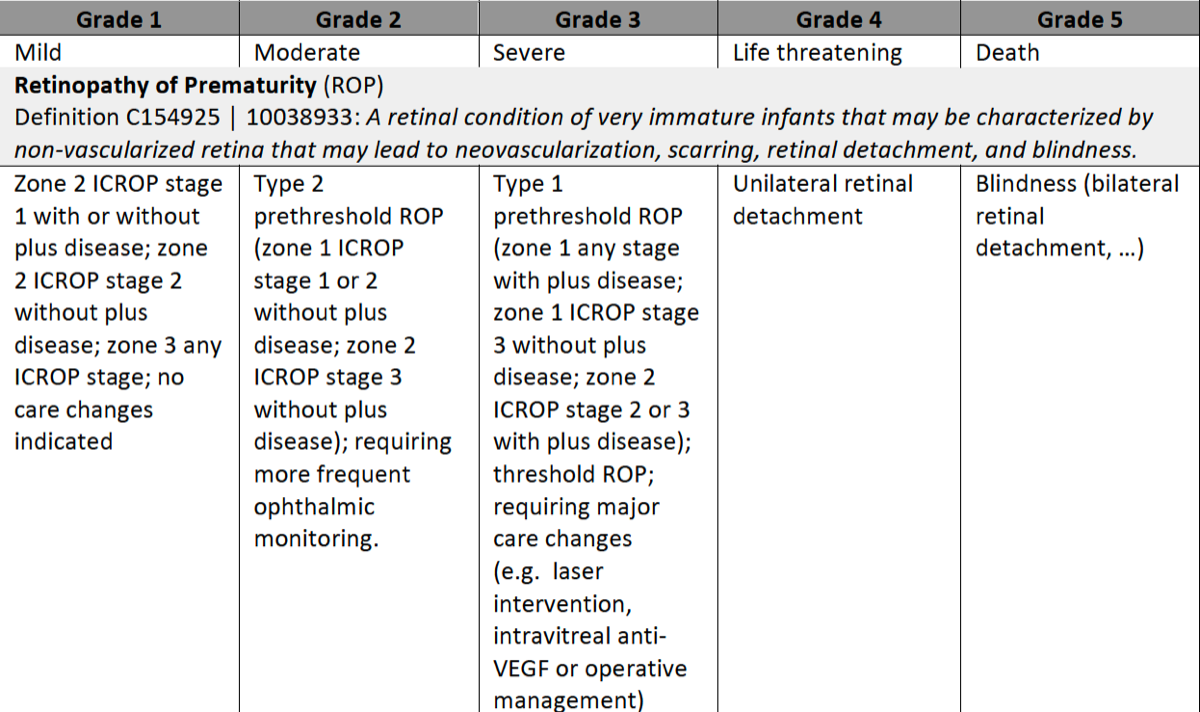
Additional Information and Considerations for the SAE Narrative:- Clinical manifestations and course
- Retinal exam finding
- Possible causes or contributing factors
- Treatment (e.g., Avastin, laser, surgery), including date of procedure/surgery, interventions (e.g., change in SpO2 parameters), and response
-
Bronchopulmonary Dysplasia (BPD)expand_less
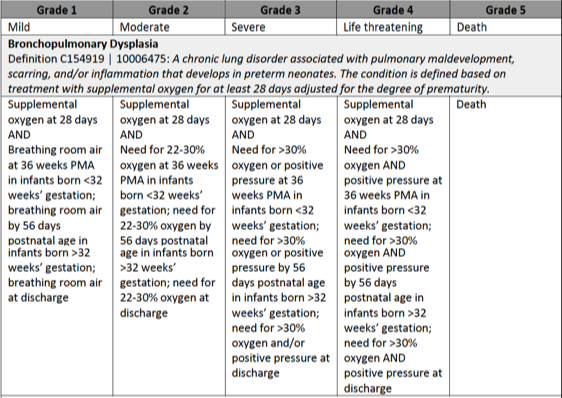
Additional Information and Considerations for the SAE Narrative:- Clinical manifestations (including exacerbations) and course
- Provide oxygen requirement and respiratory support at DOL 28 and PMA 36 weeks
- Radiographic and ECHO findings
- Relevant laboratory tests (e.g., Blood gas, electrolytes, hemoglobin/hematocrit, BNP)
- Possible causes or contributing factors
- Treatment, interventions, and response
-
Infantile Apnea (includes Apnea of Prematurity)expand_less
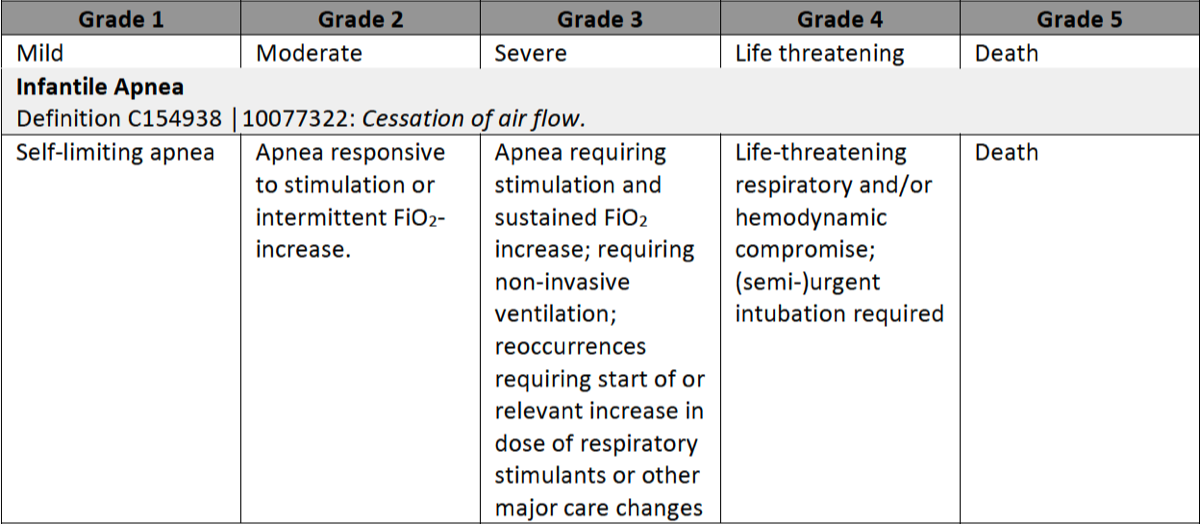
Additional Information and Considerations for the SAE Narrative:- Clinical manifestations (include abnormalities in vital signs and respiratory exam) and course
- Provide oxygen requirement and respiratory support details
- Radiographic findings and Blood gas values
- Possible causes or contributing factors
- Treatment (e.g., caffeine), interventions, and response
-
Neonatal Pneumothoraxexpand_less
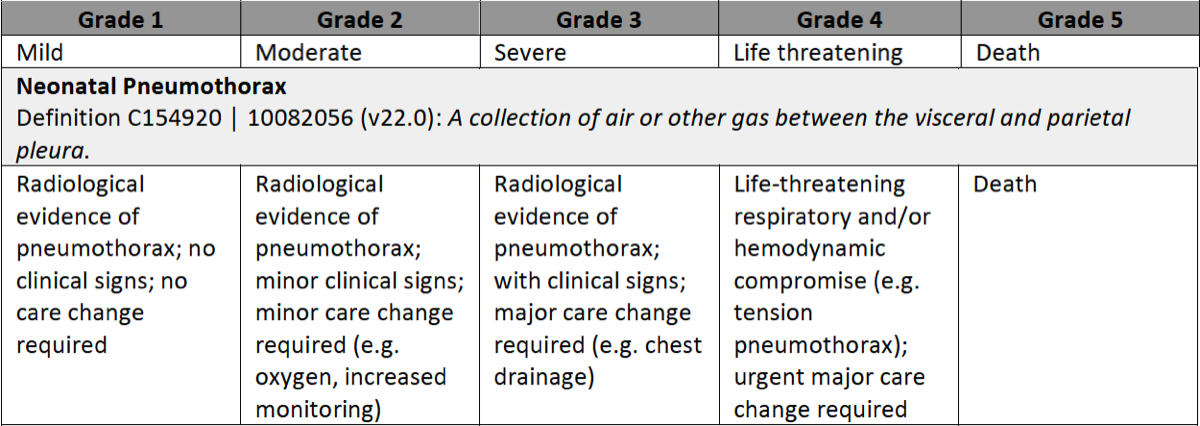
Additional Information and Considerations for the SAE Narrative:- Clinical manifestations (include duration, temporal pattern, abnormalities in vital signs, and respiratory exam) and course
- Provide oxygen requirement and respiratory support details
- Radiographic findings
- Relevant laboratory tests (e.g., Blood gas, hemoglobin/hematocrit)
- Possible causes or contributing factors
- Treatment, interventions (e.g., needle thoracentesis, chest tube placement), and response
-
Neonatal Pulmonary Hemorrhageexpand_less
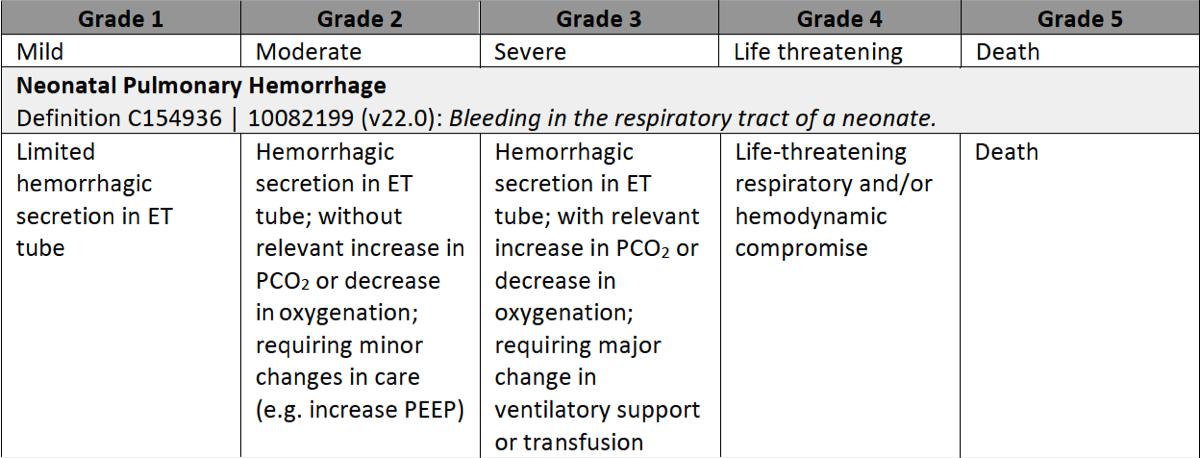
Additional Information and Considerations for the SAE Narrative:- Clinical manifestations (include duration, temporal pattern, abnormalities in vital signs, and respiratory exam) and course
- Treatment (e.g., oxygen requirement and respiratory support, endotracheal epinephrine, transfusion of blood products) and responses
- Radiographic and ECHO findings
- Relevant laboratory tests (e.g., Blood gas, hemoglobin/hematocrit, platelet count, coagulation studies)
- Possible causes or contributing factors
- Treatment (e.g., endotracheal epinephrine, transfusion of blood products), interventions (e.g., supplemental O2, respiratory support), and response
-
Neonatal Respiratory Distress Syndrome (RDS)expand_less
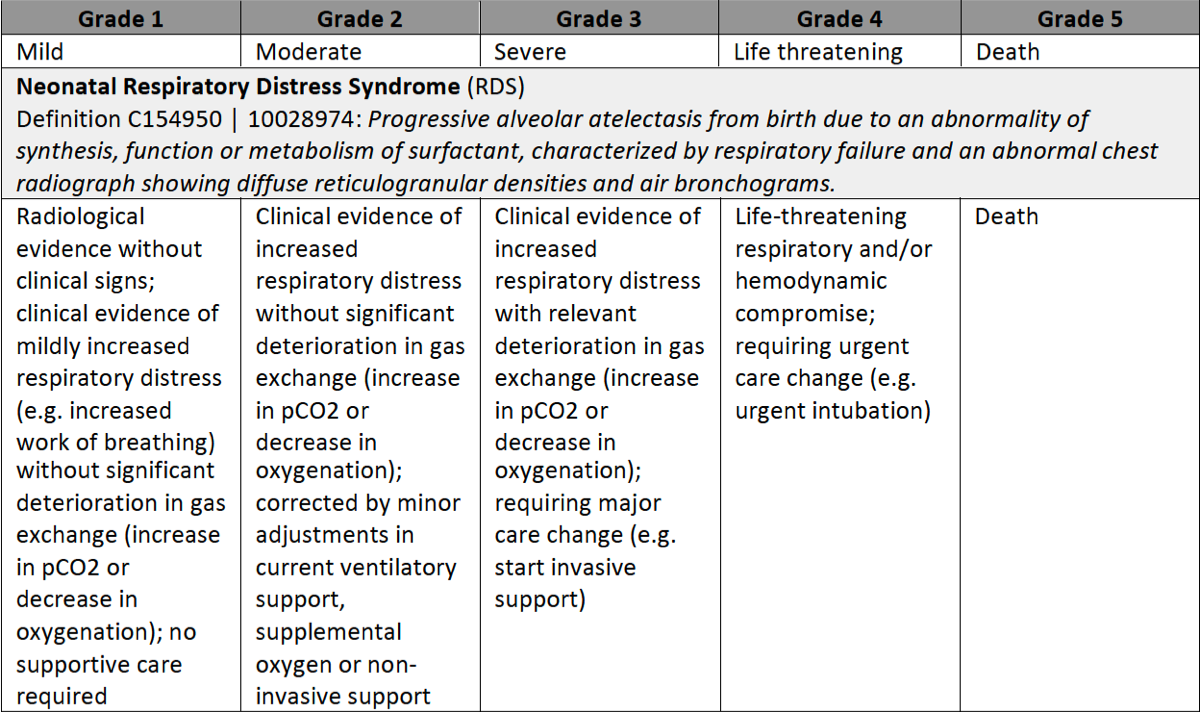
Additional Information and Considerations for the SAE Narrative:- Clinical manifestations (include abnormalities in vital signs and respiratory exam) and course
- Provide oxygen requirement and respiratory support details
- Radiographic findings and Blood gas results
- Possible causes or contributing factors
- Treatment (include # of surfactant doses), interventions, and response
-
Neonatal Respiratory Insufficiencyexpand_less
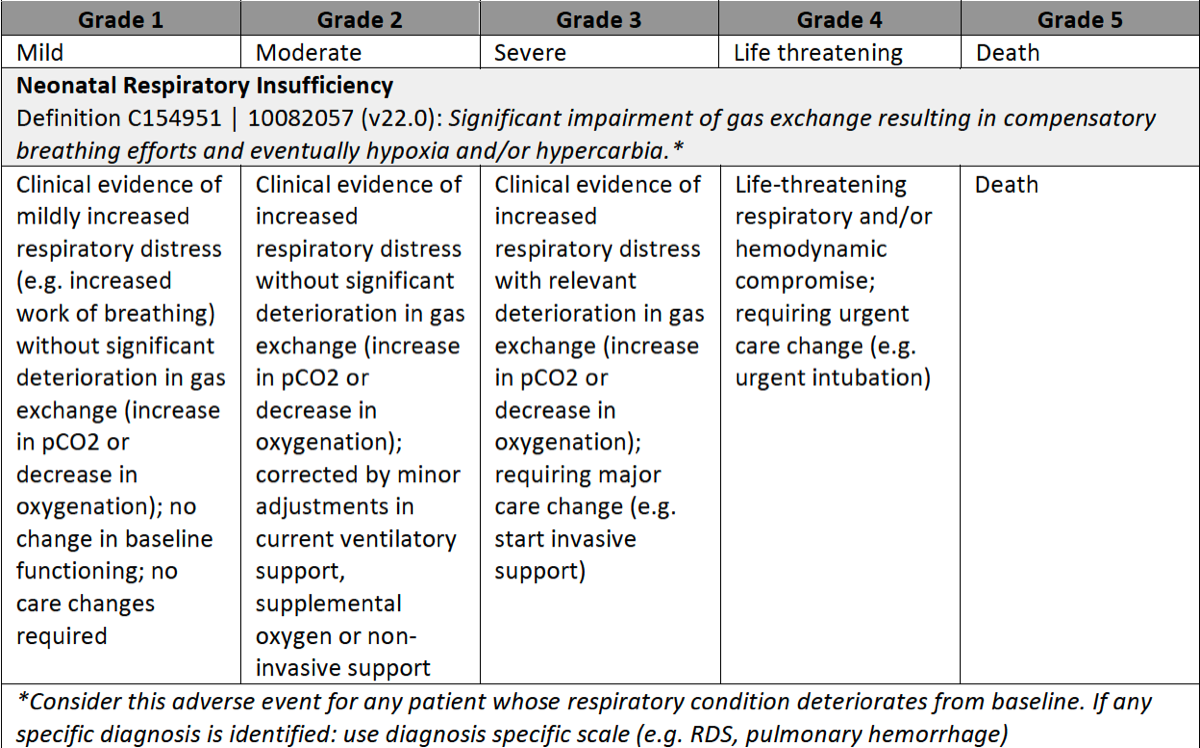
Additional Information and Considerations for the SAE Narrative:- Clinical manifestations (include abnormalities in vital signs and respiratory exam) and course
- Provide oxygen requirement and respiratory support details
- Radiographic findings and Blood gas results
- Possible causes or contributing factors
- Treatment, interventions, and response
-
Persistent Pulmonary Hypertension of the Newborn (PPHN)expand_less
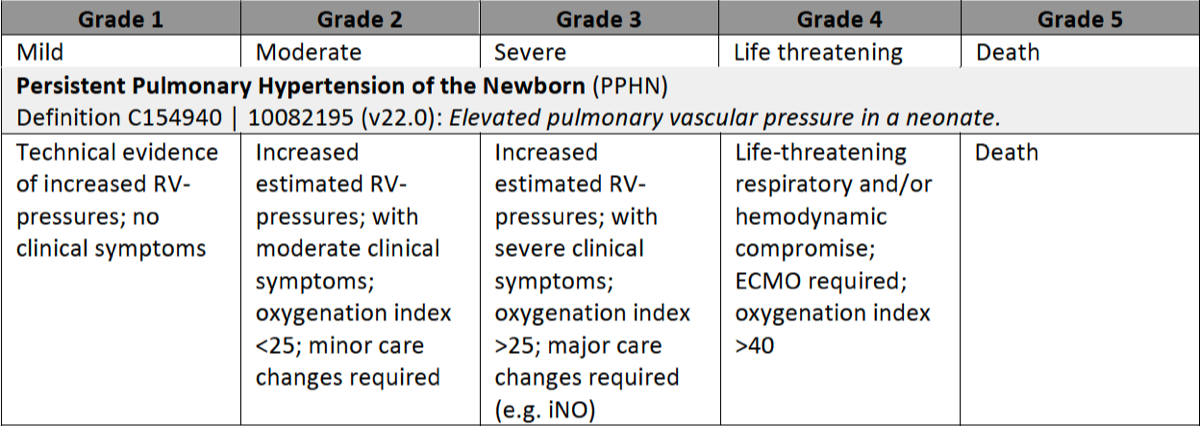
Additional Information and Considerations for the SAE Narrative:- Basis of diagnosis (e.g., ECHO findings or cardiologist assessment)
- Clinical manifestations and course
- Provide oxygen requirement and respiratory support
- Blood gas results and chest x-ray findings
- Possible causes or contributing factors
- Treatment, interventions, and response
-
Infantile HemangiomaNon-NAESS Termexpand_less
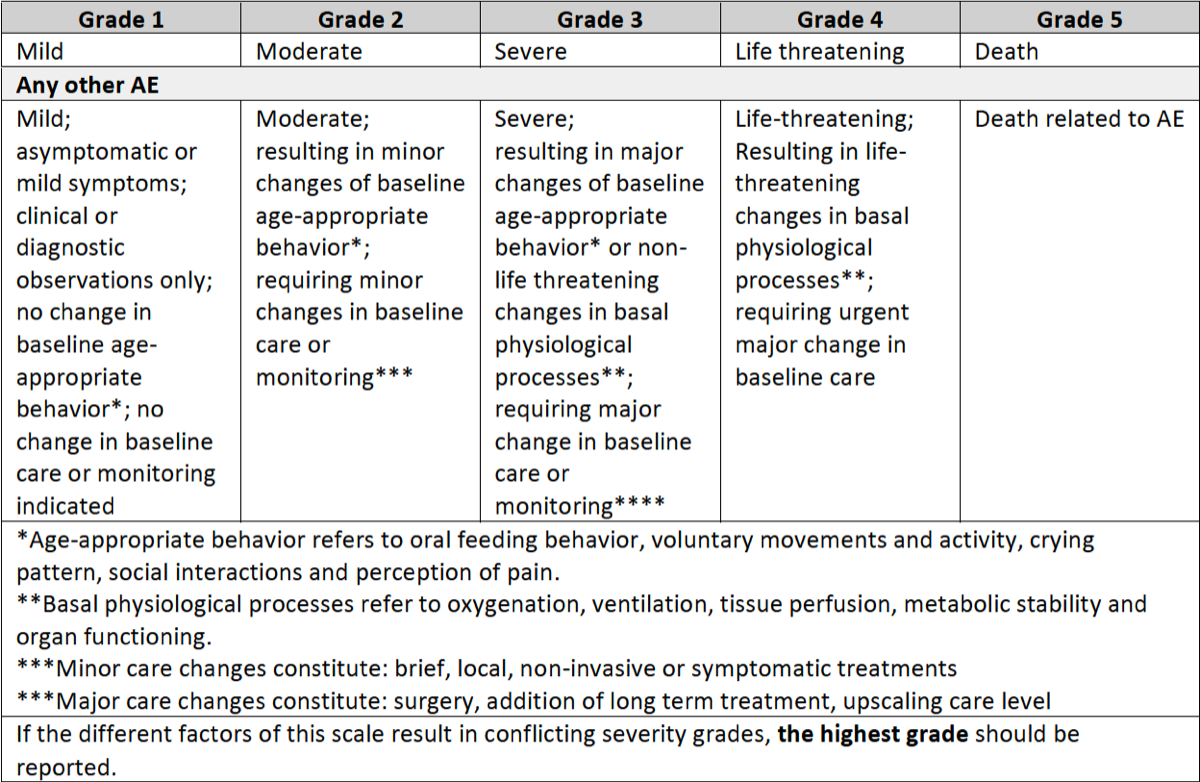
Additional Information and Considerations for the SAE Narrative:• Clinical manifestations (including location, number, and appearance) and course
• Complications (e.g., ulceration, scarring, infection, location in beard distribution)
• Ultrasound with Doppler findings, if performed
• Treatment (medical, laser, surgery) and response -
Patent Ductus Arteriosus (PDA)Non-NAESS Termexpand_less

Additional Information and Considerations for the SAE Narrative:- Clinical manifestations (including vital signs abnormalities, murmur, and signs of hemodynamically significant PDA) and course
- Radiographic and ECHO findings
- Possible contributing factors
- Treatment (diuretic, PDA-specific), interventions (interventional or surgery), and response
- If indomethacin is given, specify if prophylaxis or treatment dosing
-
Concentric Cardiac Hypertrophy (Cardiac Size Increase)Non-NAESS Term, AESIexpand_less

Additional Information and Considerations for the SAE Narrative:- ECHO findings, including changes in ventricular mass, cardiac function, and/or cardiac valves
- EKG findings including arrhythmias
- Clinical manifestations and course
- Possible causes and contributing factors
- Treatment, interventions, and response
-
Cardiomyopathy NeonatalNon-NAESS Termexpand_less

Additional Information and Considerations for the SAE Narrative:- Clinical manifestations and course
- ECHO findings
- Possible causes and contributing factors (e.g., IDM, hyperinsulinism, perinatal depression, postnatal steroid exposure, hypertension)
- Treatment, interventions, and response
-
Cardiorespiratory Arrest NeonatalNon-NAESS Termexpand_less

Additional Information and Considerations for the SAE Narrative:• Presentation and duration of arrest
• Possible causes and contributing factors
• Treatment, interventions, and response -
Hyperbilirubinemia NeonatalNon-NAESS Termexpand_less

Additional Information and Considerations for the SAE Narrative:- Total bilirubin and direct bilirubin values (prior to event, event onset, peak, and resolution) with units and reference range
- Clinical manifestations and course
- Possible causes and contributing factors
- Treatment, interventions, and response
-
Neonatal CholestasisNon-NAESS Termexpand_less

Additional Information and Considerations for the SAE Narrative:- Total bilirubin and direct bilirubin values, relevant liver function tests, GGT, INR (prior to event, event onset, peak, and resolution) with units and reference range
- Clinical manifestations and course
- Possible causes and contributing factors
- Treatment, interventions, and response
-
HypertriglyceridemiaNon-NAESS Termexpand_less

Additional Information and Considerations for the SAE Narrative:- Elevated triglyceride values (prior to event, event onset, peak, and resolution) with units and reference range
- Clinical manifestations and course
- Possible causes and contributing factors
- Treatment, interventions, and response
-
Inguinal HerniaNon-NAESS Termexpand_less

Additional Information and Considerations for the SAE Narrative:• Clinical manifestations and course
• Complications (e.g., incarceration, infection, bleeding)
• Ultrasound with Doppler findings
• Possible causes and contributing factors
• Treatment, interventions, and response -
Colitis (Excludes NEC)Non-NAESS Termexpand_less

Additional Information and Considerations for the SAE Narrative:- Clinical manifestations (including vomiting, feed intolerance, abdominal pain, diarrhea, blood in stool, fussiness/irritability) and course
- Provide details of feeding
- Radiographic (x-ray, ultrasound, enema) findings
- Possible causes and contributing factors
- Treatment, interventions, and response
-
IleusNon-NAESS Termexpand_less

Additional Information and Considerations for the SAE Narrative:• Clinical manifestations and course
• Provide details of feeding
• Radiographic (x-ray, ultrasound, enema) findings
• Possible causes and contributing factors
• Treatment, interventions, and response -
Neonatal Intestinal ObstructionNon-NAESS Termexpand_less

Additional Information and Considerations for the SAE Narrative:• Clinical manifestations and course
• Provide feeding details
• Radiographic (x-ray, ultrasound, enema) findings
• Possible causes and contributing factors
• Treatment, interventions, and response -
Neonatal PneumoniaNon-NAESS Termexpand_less

Additional Information and Considerations for the SAE Narrative:- Clinical manifestations and course
- Provide respiratory support at baseline prior to event and at event onset
- Radiographic findings
- Relevant laboratory tests (e.g., WBC, neutrophil count or %, CRP, tracheal gram stain and culture)
- Possible causes and contributing factors
- Treatment, interventions, and response
-
Neonatal MeningitisNon-NAESS Termexpand_less

Additional Information and Considerations for the SAE Narrative:- Clinical manifestations and course
- Possible causes and contributing factors
- Neuroimaging findings
- Relevant laboratory tests (e.g., WBC, neutrophil count or %, CRP, CSF gram stain, PCR, and culture)
- Treatment, interventions, and response
-
Urinary Tract Infection (UTI) NeonatalNon-NAESS Termexpand_less

Additional Information and Considerations for the SAE Narrative:- Clinical manifestations and course
- Possible causes and contributing factors
- Ultrasound findings
- Relevant laboratory tests (e.g., WBC, neutrophil count or %, CRP, urinalysis, microscopy, gram stain, and culture)
- Treatment, interventions, and responses
-
Gangrene NeonatalNon-NAESS Termexpand_less

Additional Information and Considerations for the SAE Narrative:- Clinical manifestations and course
- Include the location of affected area
- Possible causes and contributing factors
- Ultrasound with Doppler findings
- Relevant laboratory tests (e.g., WBC, neutrophil count or %, CRP, fluid or tissue gram stain and culture)
- Treatment, interventions, and response
-
CellulitisNon-NAESS Termexpand_less

Additional Information and Considerations for the SAE Narrative:- Clinical manifestations (include abnormalities in vital signs and physical exam) and course
- Details of the affected area: edema, erythema, warmth, induration, and/or pain
- Relevant laboratory tests (e.g., Blood gas, CBC, coagulation profile, CRP, cultures with organism identification and antibiotic sensitivities), including test date, site of blood culture collection, and test result with units and reference range
- Possible causes and contributing factors
- Treatment, interventions, and response
-
TracheitisNon-NAESS Termexpand_less

Additional Information and Considerations for the SAE Narrative:- Clinical manifestations and course
- Provide respiratory support at baseline prior to event and at event onset
- Radiographic findings
- Relevant laboratory tests (e.g., WBC, neutrophil count or %, CRP, tracheal gram stain and culture)
- Possible causes and contributing factors
- Treatment, interventions, and response
-
Intracranial HypertensionNon-NAESS Term, AESIexpand_less

Additional Information and Considerations for the SAE Narrative:- Clinical manifestations (include abnormalities in vital signs, neurological and fundoscopic exams, behavior changes, irritability, sleepiness, vomiting) and course
- Neuroimaging +/- lumbar puncture findings
- Possible causes and contributing factors
- Treatment, interventions, and response
-
Drug Withdrawal Syndrome NeonatalNon-NAESS Termexpand_less

Additional Information and Considerations for the SAE Narrative:- Clinical manifestations (include abnormalities in vital signs and neurologic exam, feeding difficulties or intolerance) and course
- Possible causes or contributing factors
- Treatment (e.g., analgesics, sedatives), non-pharmacologic interventions, and response
-
Encephalopathy NeonatalNon-NAESS Termexpand_less

Additional Information and Considerations for the SAE Narrative:- Clinical manifestations (include abnormalities in vital signs, neurological exam, seizures) and course
- Neuroimaging and EEG findings
- Possible causes and contributing factors
- Treatment, interventions, and response
-
Posthemorrhagic Hydrocephalus (PHH)Non-NAESS Termexpand_less

Additional Information and Considerations for the SAE Narrative:- Clinical manifestations (include abnormalities in vital signs, head circumference, neurological exam, seizures) and course
- Neuroimaging findings
- Possible causes and contributing factors
- Treatment, interventions, and response
-
Neonatal HypotoniaNon-NAESS Termexpand_less

Additional Information and Considerations for the SAE Narrative:- Clinical manifestations (include abnormalities in vital signs and neurological exam) and course
- Neuroimaging +/- EMG findings
- Relevant associated laboratory tests
- Possible causes and contributing factors
- Treatment, interventions, and response
-
Neonatal HypertoniaNon-NAESS Termexpand_less

Additional Information and Considerations for the SAE Narrative:- Clinical manifestations (including abnormalities in vital signs and neurological examination) and course
- Neuroimaging +/- EMG findings
- Relevant associated laboratory tests
- Possible causes and contributing factors
- Treatment, interventions, and response
-
Head Circumference Increased Neonatal (Excessive Brain Size)Non-NAESS Term, AESIexpand_less

Additional Information and Considerations for the SAE Narrative:- Head circumference values (prior to event, event onset, rate of increase) with units and measurement dates
- Clinical manifestations (include abnormalities in vital signs, neurological exam, seizures) and course
- Neuroimaging findings
- Possible causes and contributing factors
- Treatment, interventions, and response
-
Tonsillar / Adenoid HypertrophyNon-NAESS Term, AESIexpand_less

Additional Information and Considerations for the SAE Narrative:- Exam details of adenoid or tonsillar enlargement
- Potential complications: snoring, sleep apnea, chronic middle ear effusions, new-onset hearing loss
- Treatments, interventions, and response
-
Neonatal HypoxiaNon-NAESS Termexpand_less

Additional Information and Considerations for the SAE Narrative:- SpO2 values (prior to event, event onset, nadir, and resolution) and NICU’s normal reference range
- Clinical manifestations (include abnormalities in vital signs and cardiorespiratory exam) and course
- Provide oxygen requirement and respiratory support at baseline prior to event and event onset
- Radiographic findings if performed
- Relevant associated laboratory tests (e.g., complete blood count, CRP, and cultures)
- Possible causes and contributing factors
- Treatment, interventions, and response
-
Pleural EffusionNon-NAESS Termexpand_less

Additional Information and Considerations for the SAE Narrative:- Clinical manifestations (include abnormalities in vital signs and respiratory exam) and course
- Provide oxygen requirement and respiratory support at baseline prior to event and event onset
- Possible causes and contributing factors (e.g., hydrops fetalis, TTN, infection, central line)
- Relevant associated laboratory tests (e.g., complete blood count, CRP, pleural fluid analysis, and culture)
- Possible causes and contributing factors (e.g., hydrops fetalis, TTN, infection, central line
- Treatment, interventions, and response
-
ChylothoraxNon-NAESS Termexpand_less

Additional Information and Considerations for the SAE Narrative:- Clinical manifestations (include abnormalities in vital signs and respiratory exam) and course
- Provide oxygen requirement and respiratory support at baseline prior to event and event onset
- Possible causes and contributing factors (e.g., hydrops fetalis, TTN, infection, central line)
- Radiographic findings
- Relevant associated laboratory tests (e.g., WBC, neutrophil count or percent, CRP, pleural fluid analysis, and culture)
- Possible causes and contributing factors (e.g., hydrops fetalis, TTN, infection, central line
- Treatment, interventions, and response
-
BronchiolitisNon-NAESS Termexpand_less

Additional Information and Considerations for the SAE Narrative:- Clinical manifestations (include abnormalities in vital signs and respiratory exam) and course
- Provide oxygen requirement and respiratory support at baseline prior to event and event onset
- Radiographic findings
- Relevant associated laboratory tests (e.g., complete blood count, CRP, and culture)
- Possible causes and contributing factors
- Treatment, interventions, and response
-
Neonatal Pulmonary HypertensionNon-NAESS Termexpand_less

Additional Information and Considerations for the SAE Narrative:- Basis of diagnosis (e.g., ECHO findings or cardiologist assessment)
- Clinical manifestations (including exacerbations) and course
- Provide oxygen requirement and respiratory support
- Chest x-ray findings
- Relevant laboratory tests: Blood gas (specify source- arterial, venous, capillary), BNP
- Possible causes or contributing factors
- Treatment, interventions, and response
-
Pulmonary Interstitial Emphysema SyndromeNon-NAESS Termexpand_less

Additional Information and Considerations for the SAE Narrative:- Clinical manifestations (include duration, temporal pattern, abnormalities in vital signs, and respiratory exam) and course
- Provide oxygen requirement and respiratory support details
- Radiographic findings
- Relevant laboratory tests (e.g., Blood gas, hemoglobin/hematocrit)
- Possible causes or contributing factors
- Treatment, interventions, and response
-
Anemia NeonatalNon-NAESS Termexpand_less

Additional Information and Considerations for the SAE Narrative:- Hemoglobin/Hematocrit values (prior to event, event onset, nadir, and resolution) with units and reference ranges
- Clinical manifestations (include poor weight gain, tachycardia, increased apnea, bradycardia, oxygen requirement, or respiratory support) and course
- Possible etiology and contributing factors
- Treatment (iron, EPO-stimulating medication, transfusions) and response
-
Hemolysis NeonatalNon-NAESS Termexpand_less

Additional Information and Considerations for the SAE Narrative:- Hemoglobin/Hematocrit and reticulocyte % values (prior to event, event onset, nadir, and resolution) with units and reference range
- Clinical manifestations (include poor weight gain, tachycardia, increased apnea, bradycardia, oxygen requirement, or respiratory support) and course
- Possible etiology and contributing factors
- Treatment, interventions, and response
-
Polycythemia NeonatorumNon-NAESS Termexpand_less

Additional Information and Considerations for the SAE Narrative:- Hemoglobin/Hematocrit values (prior to event, event onset, peak, and resolution) with units and reference ranges
- Clinical manifestations (include cyanosis, tachycardia, tachypnea, abdominal distention, vomiting, poor feeding) and course
- Associated symptoms (e.g., hypoglycemia, hyperbilirubinemia)
- Possible etiology and contributing factors
- Treatment (e.g., hydration, partial exchange transfusion) and response
-
Thrombocytopenia NeonatalNon-NAESS Termexpand_less

Additional Information and Considerations for the SAE Narrative:- Platelet values (prior to event, event onset, nadir, and resolution) with units and reference ranges
- Clinical manifestations (including petechiae, bruising, bleeding) and course
- Possible causes and contributing factors
- Treatment (IVIG, transfusion) and response
-
Abnormal Organ Growth (Excessive Growth)Non-NAESS Term, AESIexpand_less

Additional Information and Considerations for the SAE Narrative:- Provide growth parameters (weight, length, head circumference) at baseline prior or event, event onset, and rate of rise, including dates of measurement
- Clinical manifestations and course
- Possible etiology and contributing factors
- Treatment, interventions, and response
-
Neonatal HyperglycemiaNon-NAESS Termexpand_less

Additional Information and Considerations for the SAE Narrative:- Glucose values (prior to event, event onset, nadir, at resolution) with units and reference range
- Clinical manifestations (include increased urine output, dehydration, weight loss, feeding difficulty, fever) and course
- Provide details of nutrition (including enteral feeds, parenteral nutrition, and lipids)
- Other relevant laboratory tests
- Possible causes and contributing factors (e.g., IUGR/SGA, sepsis, nutrition, medications)
- Treatment, interventions, and response
-
Neonatal HypoglycemiaNon-NAESS Term, AESIexpand_less

Additional Information and Considerations for the SAE Narrative:- Lowered glucose values (prior to event onset, event onset, nadir, and resolution) with units and reference range
- Clinical manifestations (include tremors, irritability, feeding difficulty, weak cry, lethargy, hypotonia, apnea, respiratory distress, cyanosis, seizures) and course
- Other relevant hypoglycemia-related laboratory tests
- Possible causes and contributing factors (e.g., IDM, IUGR/SGA, perinatal stress, delayed feeding, medications)
- Treatment, interventions, and response
-
Late Metabolic Acidosis of NewbornNon-NAESS Termexpand_less

Additional Information and Considerations for the SAE Narrative:- pH and bicarbonate values (prior to event, event onset, nadir, at resolution) with units and reference range
- Clinical manifestations and course
- Other relevant/associated laboratory tests
- Possible causes and contributing factors
- Treatment, interventions, and response
-
Neonatal HyponatremiaNon-NAESS Termexpand_less

Additional Information and Considerations for the SAE Narrative:- Sodium values (prior to event, event onset, nadir, and resolution) with units and reference range
- Clinical manifestations and course
- Other relevant/associated laboratory tests
- Possible causes and contributing factors
- Treatment, interventions, and response
-
HypernatremiaNon-NAESS Termexpand_less

Additional Information and Considerations for the SAE Narrative:- Sodium values (prior to event, event onset, peak, and resolution) with units and reference range
- Clinical manifestations and course
- Other relevant/associated laboratory tests
- Possible causes and contributing factors
- Treatment, interventions, and response
-
HypokalemiaNon-NAESS Termexpand_less

Additional Information and Considerations for the SAE Narrative:- Potassium values (prior to event, event onset, nadir, and resolution) with units and reference range
- Clinical manifestations and course
- Other relevant/associated laboratory tests
- Possible causes and contributing factors
- Treatment, interventions, and response
-
HyperkalemiaNon-NAESS Termexpand_less

Additional Information and Considerations for the SAE Narrative:- Potassium values (prior to event, event onset, peak, and resolution) with units and reference range
- Clinical manifestations and course
- Other relevant/associated laboratory tests
- Possible causes and contributing factors
- Treatment, interventions, and response
-
Neonatal HypocalcemiaNon-NAESS Termexpand_less

Additional Information and Considerations for the SAE Narrative:- Calcium values (prior to event, event onset, nadir, and resolution) with units and reference range
- Clinical manifestations and course
- Other relevant/associated laboratory tests
- Possible causes and contributing factors
- Treatment, interventions, and response
-
Adrenal Insufficiency NeonatalNon-NAESS Termexpand_less

Additional Information and Considerations for the SAE Narrative:- Clinical manifestations (abnormalities in vital signs and physical examination) and course
- ACTH stimulation test results and other relevant laboratory tests
- Ultrasound findings
- Possible causes and contributing factors
- Treatment, interventions, and response
-
Disturbance of Thermoregulation of NewbornNon-NAESS Termexpand_less

Additional Information and Considerations for the SAE Narrative:- Temperature values (prior to event, event onset, nadir/peak, and resolution) with units and reference range
- Clinical manifestations and course
- Possible causes and contributing factors
- Relevant laboratory tests (e.g., WBC, neutrophil count or percent, CRP, and cultures)
- Treatment, interventions, and response
-
Acute Kidney Injury (AKI)Non-NAESS Termexpand_less

Additional Information and Considerations for the SAE Narrative:- Creatinine values (prior to event, event onset, peak, and resolution) with units and reference range
- Clinical manifestations and course
- Mechanical obstruction, nephrotoxic medications)
- Ultrasound findings
- Relevant associated laboratory tests (e.g., WBC, neutrophil count or %, CRP, pleural fluid analysis, culture)
- Possible causes and contributing factors: mechanical obstruction, nephrotoxic medications
- Treatment, interventions, and response
-
Chronic Kidney Disease (CKD)Non-NAESS Termexpand_less

Additional Information and Considerations for the SAE Narrative:- Creatinine values (prior to event, event onset, peak, and resolution) with units and reference range
- Clinical manifestations and course
- Ultrasound findings
- Associated laboratory tests (e.g., WBC, neutrophil count or %, CRP, urinalysis, microscopy, culture) with units and reference range
- Possible causes and contributing factors (e.g., structural abnormalities of kidney and urinary tract, genetic, AKI, hypertension, pyelonephritis)
- Treatment, interventions, and response
No Results Found

